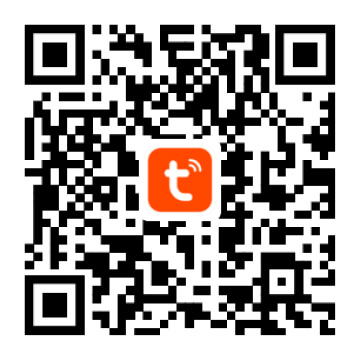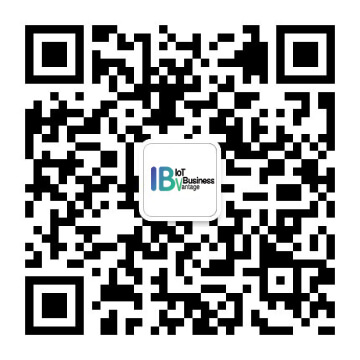TYAUX-J2 模组规格书
更新时间:2025-11-13 09:55:07下载pdf
TYAUX-J2 是由杭州涂鸦信息技术有限公司开发的一款低功耗嵌入式 Wi-Fi + 蓝牙模组。它由一个高集成度的无线射频芯片 W701-VA2-CG 构成,内置了 Wi-Fi 网络协议栈和丰富的库函数。
产品概述
TYAUX-J2 包含低功耗的 KM4 MCU、WLAN MAC 和 1T1R WLAN,最高主频 100MHz,内置 256 KB SRAM,芯片内置 2 MB Flash 和丰富的外设资源。
TYAUX-J2 是一个 RTOS 平台,集成了所有 Wi-Fi MAC 以及 TCP/IP 协议的函数库。用户可以基于这些开发满足自己需求的嵌入式 Wi-Fi 产品。
特性
- 内置低功耗 KM4 MCU,可以兼作应用处理器
- 主频 100MHz
- 工作电压:4.5V-18V
- 外设:1×UART
- Wi-Fi/蓝牙连通性
- 802.11 B/G/N20
- 通道 1-14@2.4GHz(CH1-11 for US/CA,CH1-13 for EU/CN)
- 支持 WEP/WPA/WPA2/WPA2 PSK(AES)安全模式
- 支持 Bluetooth 4.2 Low Energy
- 支持 SmartConfig 功能,包括 Android 和 iOS 设备
- 板载 PCB Onboard 天线
- 通过 CE 和 FCC 认证
- 工作温度:-20℃ 到 85℃
应用领域
- 智慧楼宇
- 智慧家居
- 智能插座
- 智能灯具
- 智能公交
- 工业无线控制
- 婴儿监控器
- 网络摄像头
模组接口
尺寸封装
- TYAUX-J2 尺寸大小:50.85±0.35 mm (W) × 19.5±0.35 mm (L) × 4.6±0.15 mm (H)。TYAUX-J2 尺寸图如下图所示:
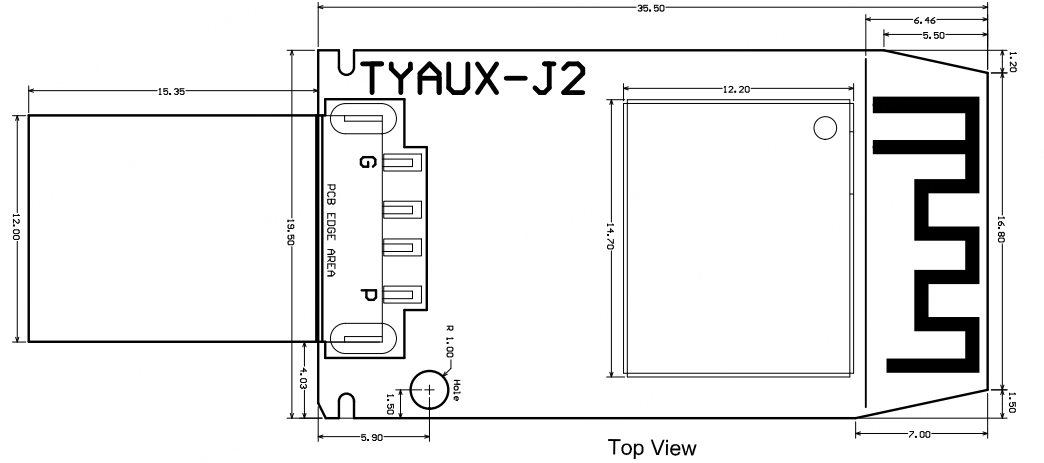

电气参数
绝对电气参数
| 参数 | 描述 | 最小值 | 最大值 | 单位 |
|---|---|---|---|---|
| Ts | 存储温度 | -40 | 105 | ℃ |
| VDD | 供电电压 | -0.3 | 18 | V |
| 静电释放电压(人体模型) | TAMB-25℃ | - | 2 | KV |
| 静电释放电压(机器模型) | TAMB-25℃ | - | 0.5 | KV |
工作条件
| 参数 | 描述 | 最小值 | 典型值 | 最大值 | 单位 |
|---|---|---|---|---|---|
| Ta | 工作温度 | -20 | - | 85 | ℃ |
| VDD | 工作电压 | 4.5 | 12 | 18 | V |
| VIL | I/O 低电平输入 | - | - | 0.8 | V |
| VIH | I/O 高电平输入 | 2.0 | - | - | V |
| VOL | I/O 低电平输出 | - | - | 0.4 | V |
| VOH | I/O 高电平输出 | 2.4 | - | - | V |
| Imax | I/O 驱动电流 | - | - | 16 | mA |
| Cpad | 输入引脚电容 | - | 2 | - | pF |
射频功耗
-
TX 连续发送时功耗:
符号 模式 功率 平均值 峰值(典型值) 单位 IRF 11b 1Mbps 17dBm 78 190 mA IRF 11b 11Mbps 17dBm 82 193 mA IRF 11g 6Mbps 17dBm 75 188 mA IRF 11g 54Mbps 15dBm 62 179 mA IRF 11n BW20 MCS0 17dBm 68 192 mA IRF 11n BW20 MCS7 14dBm 55 198 mA -
RX 连续接收时功耗:
符号 模式 平均值 峰值(典型值) 单位 IRF 11B 11M 22 124 mA IRF 11G 54M 23 128 mA IRF 11N HT20 MCS7 23 125 mA
工作功耗
| 工作模式 | 工作状态,TA=25℃ | 平均值 | 峰值(典型值) | 单位 |
|---|---|---|---|---|
| 快连配网状态(蓝牙配网) | 模组处于蓝牙配网状态,Wi-Fi 指示灯快闪 | 28 | 198 | mA |
| 快连配网状态(热点模式配网) | 模组处于热点配网状态,Wi-Fi 指示灯慢闪 | 31 | 196 | mA |
| 快连配网状态(快连模式配网) | 模组处于快连配网状态,Wi-Fi 指示灯快闪 | 29 | 194 | mA |
| 网络连接空闲状态 | 模组处于联网工作状态,Wi-Fi 指示灯常亮 | 26 | 196 | mA |
| 网络连接操作状态 | 模组处于联网工作状态,Wi-Fi 指示灯常亮 | 28 | 199 | mA |
| 弱网连接状态 | 模组和热点处于弱网连接状态,Wi-Fi 指示灯常亮 | 31 | 198 | mA |
| 网络断连状态 | 模组处于断网工作状态,Wi-Fi 指示灯常灭 | 32 | 201 | mA |
| 模组 Disable 状态 | 模组处于 EN 拉低状态 | 0.5 | 1.2 | mA |
射频参数
基本射频特性
| 参数项 | 详细说明 |
|---|---|
| 频率范围 | 2.400~2.4835GHz |
| Wi-Fi 标准 | IEEE 802.11b/g/n(通道 1-14) |
| 蓝牙标准 | 蓝牙 4.2 |
| 数据传输速率 |
|
| 天线类型 | PCB 天线,Peak 增益 3.16 dBi |
发射性能
-
TX 连续发送性能:
参数项 最小值 典型值 最大值 单位 RF 平均输出功率,802.11b CCK Mode,1 Mbps - 17 - dBm RF 平均输出功率,802.11g OFDM Mode,54 Mbps - 14 - dBm RF 平均输出功率,802.11n OFDM Mode,MCS7 - 13 - dBm RF 平均输出功率,蓝牙 4.2,1 Mbps - 6.5 - dBm 频率误差 -20 - 20 ppm EVM@802.11b CCK 11 Mbps Mode,17 dBm - - -10 dB EVM@802.11g OFDM 54 Mbps Mode,14 dBm - - -29 dB EVM@802.11n OFDM MCS7 Mode,13 dBm - - -30 dB
-
接收性能:
参数项 最小值 典型值 最大值 单位 PER<8%,RX 灵敏度,802.11b CCK Mode,1 Mbps - -96 - dBm PER<10%,RX 灵敏度,802.11g OFDM Mode,54 Mbps - -75 - dBm PER<10%,RX 灵敏度,802.11n OFDM Mode,MCS7 - -72 - dBm PER<10%,RX 灵敏度,蓝牙 4.2,1 Mbps - -93 - dBm
天线信息
天线类型
只有 PCB 板载天线接入方式,天线 Peak 增益 3.16 dBi。
降低天线干扰
在 Wi-Fi 模组上使用 PCB 板载天线时,为确保 Wi-Fi 性能的最优化,建议模组天线部分和其他金属件距离至少在 15mm 以上。
上电下电时序
上电时序
W701 芯片对上电时序有要求,建议 3.3V 电压从 0V 爬升到 3.3V 的时间在 20ms 之内。
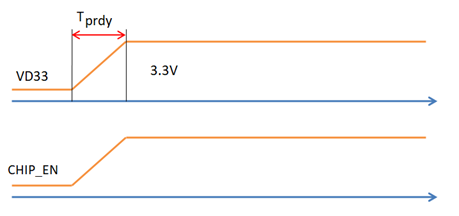
下电时序
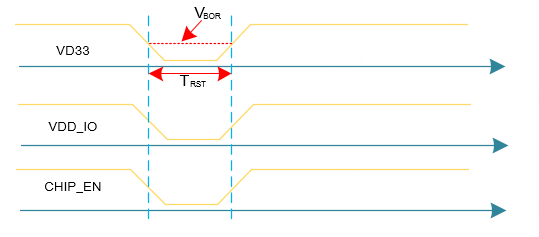
| Symbol | 参数 | 最小值 | 典型值 | 最大值 | 单位 |
|---|---|---|---|---|---|
| TPRDY | 3.3V ready time | 0.6 | - | 20 | ms |
| CHIP_EN | CHIP_EN ready time |
0.6 | - | 20 | ms |
| VBOR | Brown-out reset (BOR) occurs after 3.3V is lower than this voltage | 2 | - | - | V |
| TRST | The required time that 3.3V is lower than VBOR | 1 | - | - | ms |
封装信息及生产指导
机械尺寸
TYAUX-J2 的 PCB 机械尺寸大小:19.5±0.35 mm (W)×35.5±0.35 mm (L) ×1.0±0.15 mm (H)。TYAUX-J2 的机械尺寸如下图所示。
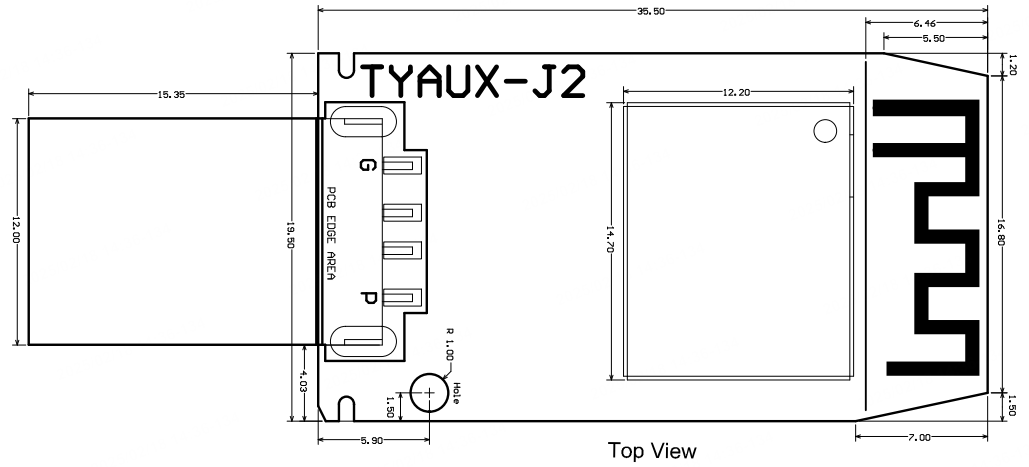
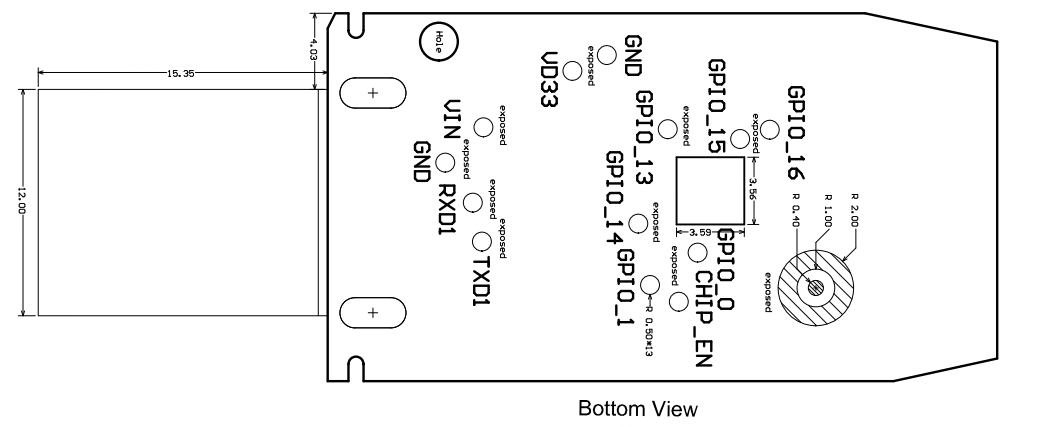

默认的尺寸公差为 ± 0.35mm,关键尺寸如果客户有明确要求,请沟通后在规格书中进行明确的标定。
生产指南
-
涂鸦出厂的贴片封装模组建议使用 SMT 机器贴片,拆开包装后建议在 24 小时内完成焊接。如果拆封后未使用完,建议放置在湿度不超过 10%RH 的干燥柜内,或重新进行真空包装并记录暴露时间。总暴露时间不超过 168 小时。
- SMT 贴片所需仪器或设备:
- 贴片机
- SPI
- 回流焊
- 炉温测试仪
- AOI
- 烘烤所需仪器或设备:
- 柜式烘烤箱
- 防静电耐高温托盘
- 防静电耐高温手套
- SMT 贴片所需仪器或设备:
-
涂鸦出厂的模组存储条件如下:
-
防潮袋必须储存在温度 <40℃、湿度 <90%RH 的环境中
-
干燥包装的产品,保质期为从包装密封之日起 12 个月的时间
-
密封包装内装有湿度指示卡:
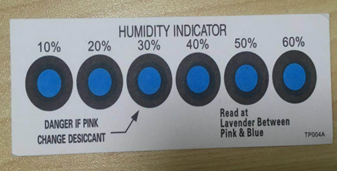
-
-
涂鸦出厂的模组当出现可能受潮的情况下需要进行烘烤:
- 拆封前发现真空包装袋破损。
- 拆封后发现包装袋内没有湿度指示卡。
- 拆封后如果湿度指示卡读取到 10% 及以上色环变为粉色。
- 拆封后总暴露时间超过 168 小时。
- 从首次密封包装之日起超过 12 个月。
-
烘烤参数如下:
- 烘烤温度:卷盘包装 40℃,小于等于 5%RH。托盘包装 125℃,小于等于 5%RH(耐高温托盘非吸塑盒拖盘)。
- 烘烤时间:卷盘包装 168 小时,托盘包装 12 小时。
- 报警温度设定:卷盘包装 50℃,托盘包装 135℃。
- 自然条件下冷却到 36℃ 以下后,即可进行生产。
- 若烘烤后暴露时间大于 168 小时没有使用完,请再次进行烘烤。
- 如果暴露时间超过 168 小时未经过烘烤,不建议使用波峰焊接工艺焊接此批次模组,因模组为 3 级湿敏器件超过允许的暴露时间很可能受潮,进行高温焊接时可能导致器件失效或焊接不良。
-
在整个生产过程中,请对模组进行静电放电(ESD)保护。
-
为了确保产品合格率,建议使用 SPI 和 AOI 测试设备来监控锡膏印刷和贴装品质。
推荐炉温曲线
请根据回流焊曲线图进行温度设定,峰值温度 245℃,回流焊温度曲线如下图所示:
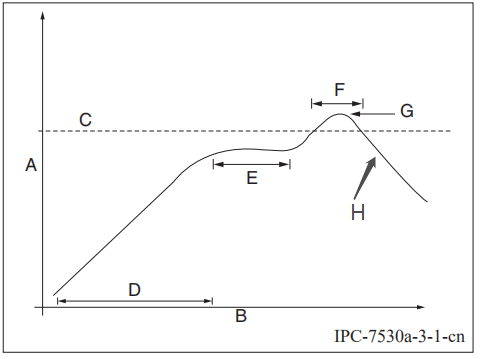
- A:温度轴
- B:时间轴
- C:合金液相线温度:217-220℃
- D:升温斜率:1-3℃/S
- E:恒温时间:60-120S,恒温温度:150-200℃
- F:液相线以上时间:50-70S
- G:峰值温度:235-245℃
- H:降温斜率:1-4℃/S
以上推荐曲线以 SAC305 合金焊膏为例。其他合金焊膏请按焊膏规格书推荐炉温曲线设置。
储存条件
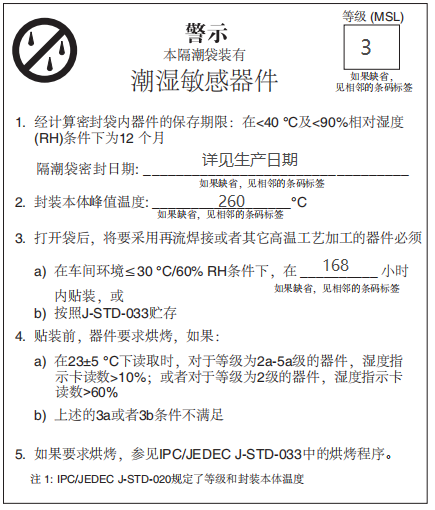
模组 MOQ 与包装信息
| 型号 | MOQ(pcs) | 出货包装方式 | 每个卷盘存放模组数 | 每箱包装卷盘数 |
|---|---|---|---|---|
| TYAUX-J2 | 3600 | 载带卷盘 | 900 | 4 |
附录:声明
FCC Caution: Any changes or modifications not expressly approved by the party responsible for compliance could void the user’s authority to operate this device.
This device complies with Part 15 of the FCC Rules. Operation is subject to the following two conditions: (1) This device may not cause harmful interference, and (2) this device must accept any interference received, including interference that may cause undesired operation.
List of applicable FCC rules
This module has been granted modular approval as below listed FCC rule parts.
FCC Rule parts 15C (15.247)
List of applicable ISED rules
This module has been certificated modular approval as below listed ISED Radio Standards Specifications.
RSS 247 Issue 3
This device generates, uses, and can radiate radio frequency energy and, if not installed and used following the instructions, may cause harmful interference to radio communications. However, there is no guarantee that interference will not occur in a particular installation. If this device does cause harmful interference to radio or television reception, which can be determined by turning the device off and on, the user is encouraged to try to correct the interference by one or more of the following measures:
• Reorient or relocate the receiving antenna.
• Increase the separation between the device and receiver.
• Connect the device to an outlet on a circuit different from that to which the
receiver is connected.
• Consult the dealer or an experienced radio/TV technician for help.
Radiation Exposure Statement
This device complies with FCC radiation exposure limits set forth for an uncontrolled rolled environment. This device should be installed and operated with a minimum distance of 20cm between the radiator and your body.
Important Note
This radio module must not be installed to co-locate and operate simultaneously with other radios in the host system except following FCC multi-transmitter product procedures. Additional testing and device authorization may be required to operate simultaneously with other radios.
The availability of some specific channels and/or operational frequency bands are country dependent and are firmware programmed at the factory to match the intended destination. The firmware setting is not accessible to the end-user.
The host product manufacturer is responsible for compliance with any other FCC rules that apply to the host not covered by the modular transmitter grant of certification. The final host product still requires Part 15 Subpart B compliance testing with the modular transmitter installed.
The end-user manual shall include all required regulatory information/warnings as shown in this manual, including “This product must be installed and operated with a minimum distance of 20 cm between the radiator and user body”.
This device has got an FCC ID: 2ANDL-TYAUX-J2. The end product must be labeled in a visible area with the following: “Contains Transmitter Module FCC ID: 2ANDL-TYAUX-J2”.
This device is intended only for OEM integrators under the following conditions:
The antenna must be installed such that 20cm is maintained between the antenna and users, and the transmitter module may not be co-located with any other transmitter or antenna.
As long as the 2 conditions above are met, further transmitter tests will not be required. However, the OEM integrator is still responsible for testing their end-product for any additional compliance requirements required with this module installed.
Declaration of Conformity European Notice

Hereby, Hangzhou Tuya Information Technology Co., Ltd declares that this module product is in compliance with essential requirements and other relevant provisions of Directive 2014/53/EU,2011/65/EU. A copy of the Declaration of conformity can be found at https://www.tuya.com.
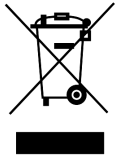
This product must not be disposed of as normal household waste, in accordance with the EU directive for waste electrical and electronic equipment (WEEE-2012/19/EU). Instead, it should be disposed of by returning it to the point of sale, or to a municipal recycling collection point.
The device could be used with a separation distance of 20cm from the human body.
Industry Canada Statement
This device complies with Industry Canada’s licence-exempt RSSs. Operation is subject to the following two conditions:
(1) This device may not cause interference.
(2) This device must accept any interference, including interference that may cause undesired operation of the device.
Le présent appareil est conforme aux CNR d’Industrie Canada applicables aux appareils radio exempts de licence. L’exploitation est autorisée aux deux conditions suivantes:
(1) l’appareil ne doit pas produire de brouillage.
(2) l’utilisateur de l’appareil doit accepter tout brouillage radioélectrique sub i, même si le brouillage est susceptible d’en compromettre le fonctionnement.
Radiation Exposure Statement
This equipment complies with IC radiation exposure limits set forth for an uncontrolled environment. This equipment should be installed and operated with minimum distance 20 cm between the radiator & your body.
Déclaration d’exposition aux radiations:
Cet équipement est conforme aux limites d’exposition aux rayonnements ISED établies pour un environnement non contrôlé. Cet équipement doit être installé et utilisé avec un minimum de 20 cm de distance entre la source de rayonnement et votre corps.
L’appareil peut interrompre automatiquement la transmission en cas d’absence d’informations à transmettre ou de panne opé rationnelle. Notez que ceci n’est pas destiné à interdire la transmission d’informations de contrôle ou de signalisation ou l’utilisation de codes répétitifs lorsque cela est requis par la technologie.
This device is intended only for OEM integrators under the following conditions:
(1) The antenna must be installed such that 20 cm is maintained between the antenna and users.
(2) The transmitter module may not be co-located with any other transmitter or antenna. As long as 2 conditions above are met, further transmitter test will not be required.
However, the OEM integrator is still responsible for testing their end-product for any additional compliance requirements required with this module installed.
Cet appareil est conçu uniquement pour les intégrateurs OEM dans les conditions
suivantes: (Pour utilisation de dispositif module)
(1) L’antenne doit être installée de telle sorte qu’une distance de 20 cm est respectée entre l’antenne et les utilisateurs.
(2) Le module émetteur peut ne pas être coïmplanté avec un autre é metteur ou antenne.
Tant que les 2 conditions ci-dessus sont remplies, des essais supplé mentaires sur l’émetteur neseront pas nécessaires. Toutefois, l’intégrateur OEM est toujours responsable des essais sur son produit final pour toutes exigences de conformité supplémentaires requis pour ce module installé.
IMPORTANT NOTE:
In the event that these conditions can not be met (for example certain laptop configurations or colocation with another transmitter), then the Canada authorization is no longer considered valid and the IC ID can not be used on the final product. In these circumstances, the OEM integrator will be responsible for re-evaluating the end product (including the transmitter) and obtaining a separate Canada authorization.
NOTE IMPORTANTE:
Dans le cas où ces conditions ne peuvent être satisfaites (par exemple pour certaines configurations d’ordinateur portable ou de certaines co-localisation avec un autre émetteur), l’autorisation du Canada n’est plus considéré comme valide et l’ID IC ne peut pas être utilisé sur le produit final. Dans ces circonstances, l’intégrateur OEM sera chargé de réévaluer le produit final (y compris l’émetteur) et l’obtention d’une autorisation distincte au Canada.
End Product Labeling
This transmitter module is authorized only for use in device where the antenna may be installed such that 20 cm may be maintained between the antenna and users. The final end product must be labeled in a visible area with the following: “Contains IC:23243-TYAUXJ2” .
Plaque signalétique du produit final
Ce module émetteur est autorisé uniquement pour une utilisation dans un dispositif où l’antenne peut être installée de telle sorte qu’une distance de 20cm peut être maintenue entre l’antenne et les utilisateurs. Le produit final doit être étiqueté dans un endroit visible avec l’inscription suivante: “Contient des IC:23243-TYAUXJ2”.
Manual Information To the End User
The OEM integrator has to be aware not to provide information to the end user regarding how to install or remove this RF module in the user’s manual of the end product which integrates this module.
The end user manual shall include all required regulatory information/warning as show in this manual.
Manuel d’information à l’utilisateur final
L’intégrateur OEM doit être conscient de ne pas fournir des informations à l’utilisateur final quant à la façon d’installer ou de supprimer ce module RF dans le manuel de l’utilisateur du produit final qui intègre ce module.
Le manuel de l’utilisateur final doit inclure toutes les informations réglementaires requises et avertissements comme indiqué dans ce manuel.
该内容对您有帮助吗?
是意见反馈该内容对您有帮助吗?
是意见反馈

